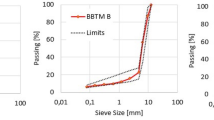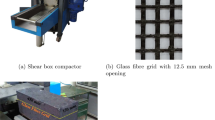Abstract
The addition of fibres to reinforce asphalt mixtures is a prospective field for pavement engineering, where the use of glass or synthetic macrofibers could potentially help not only as reinforcement for new asphalt mixtures, but also as part of asphalt overlays applied on deteriorated pavements to diminish reflective cracking during maintenance operations. In recent studies, it has been found that the addition of macrofibres can improve the rutting and fracture resistance of asphalt mixtures. However, the response of these mixtures to fatigue has not been studied yet. In this study, a complete performance characterization of a gap graded asphalt mixture with the addition of glass and synthetic macrofibres was studied. Also, a reference asphalt mixture without macrofibres was provided for comparison. Results showed that the addition of macrofibres improves water sensibility, rutting performance and stiffness of the gap grade asphalt mixtures studied. Also, it was observed during the fatigue tests that the incorporation of both types of macrofibres greatly improved the durability of the mixtures to fatigue cracking at medium range temperatures. This improved fatigue behaviour correlates to an extended useful life for the fibre reinforced asphalt mixtures. The synthetic macrofibres showed better fatigue behaviour at lower temperatures, while glass macrofibres gave a better response at the higher temperature studied.








Similar content being viewed by others
References
Pereira P, Pais J (2017) Main flexible pavement and mix design methods in Europe and challenges for the development of an European method. J Traffic Transp Eng 4(4):316–346
Dormon GM, Metcalf CT (1965) Design curves for flexible pavements based on layered system theory. Highway research record 71. Highway Research Board, pp 69–84
Navarro Moreno F, Sol-Sánchez M, Tomás-Fortún E, Rubio-Gámez M (2016) High-modulus asphalt mixtures modified with acrylic fibers for their use in pavements under severe climate conditions. J Cold Reg Eng 30:30–34. https://doi.org/10.1061/(ASCE)CR.1943-5495.0000108
Haas R, Falls RC, Macleod D, Tighe S (2004) Climate impacts and adaptations on roads in Northen Canada. Cold climates conference, Regina, AB, Canada
National Cooperative Highway Research Program (NCHRP). (2004) Mechanistic-empirical design of new and rehabilitated pavement structures. NCHRP Project 1-37A. National Research Council, Washington, DC
European Commission (EC) (1999). European Commission (EC) Development of new bituminous pavement design method cost action, 333
Eberhardsteiner L, Blab R (2019) Design of bituminous pavements—a performance-related approach. Road Mater Pavement Des 20:244–258. https://doi.org/10.1080/14680629.2017.1380689
Blab R, Eberhardsteiner L, Haselbauer K, Marchart B, Hessmann T (2014). Implementierung des GVO- und LCCA-Ansatzes in die österreichische Bemessungsmethode für Straßenoberbauten [implementation of the performance-based approach and life-cycle cost analysis in the Austrian design method for bituminous pavements]. Bericht für die ASFiNAG (FFG-Projektnr. 2824558) (in German)
Angelone S, Martinez F, Cauhape Casaux M (2016) A comparative study of bituminous mixtures with recycled polyethylene added by dry and wet processes. In: 8th RILEM international symposium on testing and characterization of sustainable and innovative bituminous materials, RILEM Bookseries. https://doi.org/10.1007/978-94-017-7342-3_47
Moghadas Nejad F, Azarhoosh AR, Hamedi GHH, Azarhoosh MJ (2012) Influence of using nonmaterial to reduce the moisture susceptibility of hot mix asphalt. Constr Build Mater 31:384–388. https://doi.org/10.1016/j.conbuildmat.2012.01.004
Moreno-Navarro F, Iglesias GR, Rubio-Gámez MC (2016) Experimental evaluation of using stainless steel slag to produce mechanomutable asphalt mortars for their use in smart materials. Smart Mater Struct 25(11):115036
Musa N, Aman M, Shahadan Z, Taher M, Noranai Z (2019) Utilization of synthetic reinforced fiber in asphalt concrete—a review. Int J Civ Eng Technol 10(05):678–694
Tanzadeh J, Reza Shahrezagamasaei R (2017) Laboratory assessment of hybrid fiber and nano-silica on reinforced porous asphalt mixtures. Constr Build Mater 144:260–270. https://doi.org/10.1016/j.conbuildmat.2017.03.184
Xiong R, Fang J, Xu A, Guan B, Liu Z (2015) Laboratory investigation on the brucite fiber reinforced asphalt binder and asphalt concrete. Constr Build Mater 83:44–52. https://doi.org/10.1016/j.conbuildmat.2015.02.089
Kumar P, Sikdar PK, Bose S, Chandra S (2004) Use of jute fibre in stone matrix asphalt. Road Mater Pavement Des 5(2):239–249. https://doi.org/10.1080/14680629.2004.9689971
Hassan H, Al-Jabri K (2005) Effect of organic fibers on open-graded friction course mixture properties. Int J Pavement Eng 6(1):67–75. https://doi.org/10.1080/10298430500087936
Woodside A, Woodward W, Akbulut H (1998) Stone mastic asphalt: assessing the effect of cellulose fibre additives. In: Proceedings of the institution of civil engineers-municipal engineer, pp 103–108
Drüschner L, Schäfer V (2000) Stone mastic asphalt. German Asphalt Association, Berlin
Norambuena-Contreras J, Serpell R, Valdés Vidal G, González A, Schlangen E (2016) Effect of fibres addition on the physical and mechanical properties of asphalt mixtures with crack-healing purposes by microwave radiation. Constr Build Mater 127:369–382. https://doi.org/10.1016/j.conbuildmat.2016.10.005
Mohammed A, Hasan A (2016) Laboratory evaluation of modified porous asphalt mixtures. Appl Res J 2(3):104–117
Guo Q, Li L, Cheng Y, Jiao Y, Xu C (2015) Laboratory evaluation on performance of diatomite and glass fiber compound modified asphalt mixture. Mater Des 66:51–59. https://doi.org/10.1016/j.matdes.2014.10.033
Park P, El-Tawil S, Park S, Naaman A (2015) Cracking resistance of fiber reinforced asphalt concrete at – 20 °C. Constr Build Mater 81:47–57. https://doi.org/10.1016/j.conbuildmat.2015.02.005
Yoo P, Kim K (2014) Thermo-plastic fiber’s reinforcing effect on hot-mix asphalt concrete mixture. Constr Build Mater 59:136–143. https://doi.org/10.1016/j.conbuildmat.2014.02.038
Qian S, Ma H, Feng J, Yang R, Huang X (2014) Fiber reinforcing effect on asphalt binder under low temperature. Constr Build Mater 61:120–124. https://doi.org/10.1016/j.conbuildmat.2014.02.035
Liu Q, Schlangen E, van de Ven M, van Bochove G, van Montfort J (2012) Evaluation of the induction healing effect of porous asphalt concrete through four-point bending fatigue test. Constr Build Mater 29:403–409. https://doi.org/10.1016/j.conbuildmat.2011.10.058
Serin S, Morova N, Saltan M, Terz S (2012) Investigation of usability of steel fibers in asphalt concrete mixtures. Constr Build Mater 36:238–244. https://doi.org/10.1016/j.conbuildmat.2012.04.113
Chen H, Xu Q (2010) Experimental study of fibers in stabilizing and reinforcing asphalt binder. Fuel 89:1616–1622. https://doi.org/10.1016/j.fuel.2009.08.020
Mahrez A, Karim M (2010) Fatigue characteristics of SMA reinforced with fibre glass. Int J Phys Sci 5(12):1840–1847
Arabani M, Amir Shabani A, Hamedi G (2019) Experimental investigation of effect of ceramic fibers on mechanical properties of asphalt mixtures. J Mater Civ Eng 31(9):04019203
Slebi-Acevedo C, Lastra-González P, Indacoechea-Vega I, Castro-Fresno D (2020) Laboratory assessment of porous asphalt mixtures reinforced with synthetic fibers. Constr Build Mater 234:117224. https://doi.org/10.1016/j.conbuildmat.2019.117224
González A, Norambuena-Contreras J, Storey L, Schlangen E (2018) Effect of RAP and fibers addition on asphalt mixtures with self-healing properties gained by microwave radiation heating. Constr Build Mater 159:164–174
Morea F, Zerbino R (2018) Improvement of asphalt mixture performance with glass macro-fibers. Constr Build Mater 164:113–120. https://doi.org/10.1016/j.conbuildmat.2017.12.198
Morea F, Zerbino R (2018) Incorporation of synthetic macrofibres in warm mix asphalt. Road materials and pavement design. Published online 28 Jun 2018. https://doi.org/10.1080/14680629.2018.1487874
PG3: Pliego de Prescripciones Técnicas Generales para Obras de Carreteras y Puentes de la Dirección General de Carreteras y Caminos Vecinales (PG-3/75). Ministerio de Fomento de España (2015)
Steiner D, Hofko B, Blab R (2016) Effect of air void content and repeated testing on stiffness of asphalt mix specimen. In: 7th civil engineering conference in the Asian region
Moreno-Navarro F, Rubio-Gámez MC (2013) UGR-FACT test for the study of fatigue cracking in bituminous mixes. Constr Build Mater 43:184–190
Acknowledgements
The authors wish to thank and acknowledge the University of Granada and the National University of La Plata which made possible the development of this research. We would also like to give a special recognition to the doctor Gema García Travé for all her support during this research. A special recognition to Natalia Soledad Alvarez, nothing would have been possible without all your support. Rest in peace. With love Francisco.
Author information
Authors and Affiliations
Corresponding author
Additional information
Publisher's Note
Springer Nature remains neutral with regard to jurisdictional claims in published maps and institutional affiliations.
Rights and permissions
About this article
Cite this article
Morea, F., Sol-Sanchez, M., Moreno-Navarro, F. et al. Fatigue behaviour of macrofiber reinforced gap graded asphalt mixtures. Mater Struct 53, 74 (2020). https://doi.org/10.1617/s11527-020-01511-x
Received:
Accepted:
Published:
DOI: https://doi.org/10.1617/s11527-020-01511-x




